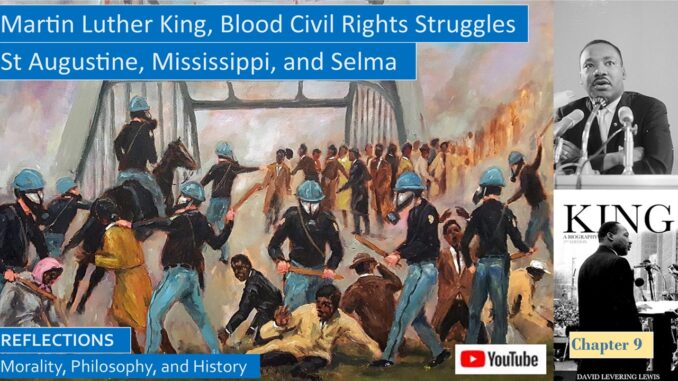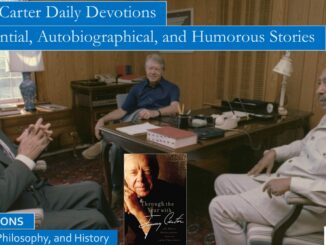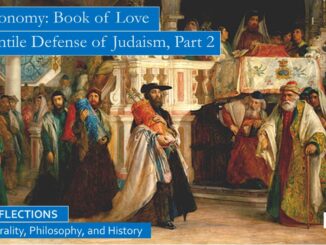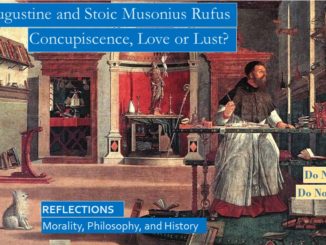
Today we are reflecting on those chapters in David Levering Lewis’ biography of Martin Luther King covering his continuing civil rights struggles in St Augustine, in registering voters in Mississippi, and his famous march from Selma to Montgomery, Alabama. We reflect on these questions:
Who were the many martyrs, both black and white, who died in the struggle for civil rights in America?
Why were white supremacists so quick to turn to violence, often murderous violence, when they knew their actions would be televised for all to see?
Why was President Lyndon Johnson committed to passing Civil Rights legislation? How did he and Martin Luther King collaborate to further the cause of Civil Rights?
Script for this video, with more Amazon book links: https://www.slideshare.net/slideshows/martin-luther-king-bloody-struggles-in-mississippi-and-selma-lewis-biography-chapters-89/265591094
YouTube video for this blog: https://youtu.be/eMA_7vLYcdM
PRIOR REFLECTIONS
What were the events leading up to his famous march on Selma? Previously we have reflected on Martin’s youth and schooling, then the Montgomery Bus Boycott, when Martin Luther King first gained national prominence due to the national media attention. Martin then assisted in the struggles to desegregate first lunch counters with student sit-in protests, and then the Freedom Rider protesters seeking to desegregate interstate buses and bus stations. Next came the brutality and bombing in Birmingham, where four children were martyred when their church was bombed during Sunday School. This was followed by the hopeful March on Washington and Martin Luther King’s I Have a Dream speech.
Martin Luther King, Youth and Schooling, Lewis’ Biography Chapters, 1 and 2
https://seekingvirtueandwisdom.com/martin-luther-king-youth-and-schooling-lewis-biography-chapters-1-and-2/
https://youtu.be/_64FMZ6AlEg
Martin Luther King and Rosa Parks, Montgomery Bus Boycott, Lewis’ Biography, Chapter 3
https://seekingvirtueandwisdom.com/martin-luther-king-and-rosa-parks-montgomery-bus-boycott-lewis-biography-chapter-3/
https://youtu.be/TuiyFycWE-U
Martin Luther King, Lunch Counters, Freedom Riders, and Albany, Lewis’ Biography Chapters 4-6
https://seekingvirtueandwisdom.com/martin-luther-king-lunch-counters-freedom-riders-and-albany-lewis-biography-chapters-4-6/
https://youtu.be/_TLt2fQqL4w
Martin Luther King, Birmingham, Nonviolent Protests v Bombs and Brutality, Biography Chapter 7
https://seekingvirtueandwisdom.com/martin-luther-king-birmingham-nonviolent-protests-v-bombs-and-brutality-biography-chapter-7/
https://youtu.be/5y0v0tYMdy8
Comparing MLK’s Letter from Birmingham Jail with Hannah Arendt’s Banality of Evil in Nazi Germany
http://www.seekingvirtueandwisdom.com/comparing-martin-luther-kings-letter-from-the-birmingham-jail-with-hannah-arendts-the-banality-of-evil/
https://youtu.be/PqFAUEXbi8k
Martin Luther King, I Have a Dream Speech, March on Washington DC, Biography Chapter 8
https://seekingvirtueandwisdom.com/martin-luther-king-i-have-a-dream-speech-march-on-washington-dc-biography-chapter-8/
https://youtu.be/IJ64y3nQA4Q
BLOODY STRUGGLE IN ST AUGUSTINE
In his biography of Martin Luther King, David Levering Lewis tells us about the civil rights struggle in the small town of St Augustine, Florida. Lewis tells us: “Founded in 1565, St Augustine is the oldest city in America,” and it was deeply racist. “Since 1959, the courageous dentist Dr Hayling had struggled almost alone to compel St Augustine, a city of nearly 15,000, to desegregate its public facilities and permit” blacks to register to vote, he was met with “police intimidation and Klan violence. In September 1963, Dr Hayling and three other blacks were kidnapped by the KKK and rescued by the sheriff only minutes before they were incinerated with kerosene. In the following month, his home was dynamited.” Others suffered similar fates.
Dr Hayling conferred with Martin Luther King. The SCLC mounted daily demonstrations in St Augustine, the SCLC representative was knocked unconscious, and his car windshield was shattered by bullets. Even after the SCLC obtained a federal injunction forbidding the sheriff from interfering with demonstrations, both the police and vigilantes attacked the demonstrators. Martin Luther King and Ralph Abernathy were both jailed for protesting.
Previously, James Brock, the manager of the Monson Motor Lodge, had denied a room to Martin Luther King to preserve the color line. Later, when blacks dared to swim in his segregated motel pool, this same manager poured muriatic acid in the pool to drive the swimmers away. There were also unsuccessful efforts to break the color line at the whites-only St Augustine Beach.
There was some progress, a biracial committee was set up to defuse tensions. But the Jim Crow system and the KKK remained supreme in St Augustine. Later, Dr Hayling was compelled to move his practice to a more prosperous part of Florida after his white clientele dried up. Other struggles, including the voter registration efforts in Mississippi and the march in Selma, Alabama, compelled the SCLC to move on.
The failure of Martin Luther King and the SCLC to make lasting improvements in civil rights in St Augustine demonstrate that court decisions and legislation are not enough, that in the long run there needs to be strong community support among both races for social justice, that loving compassion must prevail over hatefulness. St Augustine was also the smallest town where protests were attempted, the stakes were simply not high enough to continue the struggle at that time.
FREEDOM SUMMER: VOTER REGISTRATION IN MISSISSIPPI, 1964
Mississippi, like many Southern states, was a one-party state. As only whites could join the Democratic Party, blacks could not vote in the Democratic primary where all elections were decided. Not only that, blacks were also prevented from registering to vote. To combat this, the Mississippi Freedom Party was formed, eventually enlisting 80,000 members, both black and white.
Behind this effort was a new acronym, COFO or Council of Federated Organizations, which included CORE, NAACP, SNCC, and SCLC. COFO “preached the gospel of salvation through the ballot,” which was risky, because in many small towns blacks who attempted to register to vote were sometimes lynched. In the Freedom Summer of 1964, many enthusiastic white, and a few black, college students traveled to Mississippi to assist in these voter registration efforts.
Bob Moses, who had a master’s degree in philosophy from Harvard, directed SNCC’s Mississippi voter registration effort. He advised these volunteers, “Our goals are limited. If we can go and come back alive, then that is something. If you can go into Negro homes and just sit and talk, that will be a huge job. We’re not thinking of integrating the lunch counters. The Negroes in Mississippi haven’t the money to eat in those places anyway.”
Three volunteers, one black and two white Jews, disappeared when returning from registering voters in Mississippi. Their car was found, they were not. Federal authorities became involved, LBJ ordered Navy divers to search the canals of Mississippi for bodies. They found one body, then another, then another, of blacks who had been lynched, but none were the bodies of the three students. Finally, an informant came forward to tell them where they had been buried alive with a backhoe. The full horrifying story is in our Yale Lecture Notes.
Civil Rights Era, Sixties and Beyond: Yale Lecture Notes
http://www.seekingvirtueandwisdom.com/american-civil-rights-history-yale-lecture-notes/
https://youtu.be/GQesHoV5IdI
At the Democratic Convention in Atlantic City, New Jersey, Martin Luther King initially supported the demands that delegates from the Mississippi Freedom Party be recognized that than those of the segregationist Mississippi Democratic Party. The Democratic Party, threatened with the possibility that several Southern state delegations would boycott the convention, as had happened in the 1948 Presidential Election, possibly handing the election to the Republicans, offered a compromise that two Mississippi delegates be awarded to the Freedom Party, which were merely observer seats. This compromise was rejected by the Mississippi Democratic Freedom Party.
Tensions mounted as Martin Luther King swooped in from out of town. The slim black professional class of Jackson, the state Capitol, were loyal to the NAACP, and were wary and uneasy about Martin rocking the boat. Martin was encouraging voter registration and was planning a massive nonviolent demonstration in Selma, Alabama.[1]
MANY BLOODY MARCHES FROM SELMA, ALABAMA
Selma was deeply segregated. Although blacks narrowly outnumbered whites in Selma, Alabama, only one percent of the registered voters were black. Sheriff Jim Clark was the Bull Connor of Selma, firmly determined to preserve white supremacy.
The newly elected Progressive Mayor of Selma, Joseph Smitherman, was supported by white businessmen who sought to attract Northern industry by toning down racial issues. He appointed Wilson Baker as Chief of Police to undermine the authority of Jim Clark.
Previous voter registration drives increased black registrations in Alabama from 6,000 in 1947 to 110,000 in 1964, but 370,000 eligible blacks had not registered to vote. The SCLC chose to concentrate on Selma to end barriers to voter registration. Martin Luther King swooped in to help. Hundreds who had been protesting at the courthouse were carted in police wagons to jail by Sheriff Clark, enraging Chief of Police Baker. But the brutality of Jim Clark, like that of Bull Conner, ensured great television.
Martin Luther King and Ralph Abernathy led a giant demonstration towards the courthouse, they and a thousand others were arrested in two days. As in Birmingham, many of these demonstrators were schoolchildren. After being released from jail, Martin requested that the federal court order the Selma voting registrars to allow voter registration every day rather than twice a month. Martin conferred with VP Humphrey and was assured that a strong Voting Rights Act would be presented to Congress, which passed in 1965.
There were many brutal incidents, police shot several protestors, one died from his wounds. Over a hundred young protesters were forced on a three-mile trot with deputies following in vehicles with cattle prods. An SCLC official was chained to a hospital bed when he was hospitalized for a cranial concussion from a police baton.
On a Sunday afternoon, five hundred disciplined nonviolent marchers attempted to march from their church in Selma to Montgomery to present demands for greater civil rights. Sheriff Jim Clark ordered the marchers to disperse. When they refused, the police attacked.
Our biographer Lewis recounts, “First, there was gas, then the posse on horseback galloped into the swarm of fleeing blacks with cattle prods and with clubs they flailed like maniacs. The marchers were driven back across the bridge and into the houses” of brave friends. John Lewis, with a fractured skull, and Hosea Williams “led many of the protesters back to the church. At one point, some blacks retaliated, hurling rocks and bricks at the police, even forcing Clark and his men to momentarily retreat.”
“But the combat was unequal. While the white spectators whooped approval of the rout and gave the piercing rebel yell, Sheriff Clark bellowed: ‘Get those God damn niggers!’ Protected by masks, the police and troopers hurled tear-gas canisters into the panic-stricken mob.” “At least seventeen of the marchers were seriously hurt and another forty were given emergency treatment at the local black hospital.”
Jim Clark and his men were preparing for more retaliatory violence when Wilson Baker intervened. Defusing the situation, he persuaded the marchers to retreat into the church, and talked Jim Clark into withdrawing his men. Baker likely saved many lives that day.
“In Atlanta, Martin was stunned.” He promised he would return to Selma on Tuesday to lead another march. On Monday morning, a federal Judge Frank Johnson, hearing the pleas of civil rights attorneys to prevent the police from preventing the march, instead issued an injunction forbidding the march. For the first time, Martin prepared to defy a federal injunction.
Lewis described this moment in history: “The scenario was perfect: intractable segregation in a small Southern city, courageous black common folk demanding their overdue minimal rights, and police officers whose every sadistic act reified the demonology of the South.” In short, this was great television, many who watched television that night would see images seared into their memory they would never forget.
Lyndon Johnson pleaded with the officials of the SCLC to call off the Tuesday march. But if Martin had called off the march, the momentum of the movement would be lost. Martin was torn. Lewis says that history is unclear whether an informal agreement was made. Some say that they intended to cross the Pettus Bridge and disperse. Others say Martin intended to march until halted by the Alabama police, and in a later court hearing, he testified he never intended to march all the way to Montgomery. What history is certain about was that few of the marchers carried provisions for a fifty-mile march to Montgomery.
But to a crowd of three thousand at Brown Chapel, Martin Luther King harangued the crowd: “We have the right to walk the highways, and we have the right to walk to Montgomery if our feet will get us there. I have no alternative but to lead a march from this spot to carry our grievances to the seat of the government. I have made my choice. I have got to march. I do not know what lies ahead of us. There may be beatings, jailings, tear gas. But I would rather die on the highways of Alabama than make a butchery of my conscience.” After a dramatic pause, Martin ended, “I ask you to join me today as we move on.”
The large interracial crowd marched from the church to Broad Street, led by Martin Luther King and other ministers, white and black, and black civil rights leaders. Singing spirituals, singing “We Shall Overcome,” and “Ain’t Gonna Let Nobody Turn Me Round,” they marched hand in hand towards the Pettus Bridge.
Lewis recounts what they faced. “The weather was bright, clear, and cold, and the marchers saw, well ahead of them on the other side of the Pettus Bridge, the phalanx of grim-faced troopers standing with legs apart and braced with clubs at waist level.” When they crossed the bridge, when they were fifty feet from the troopers, Major Cloud barked, “This march will not continue. It is not conducive to the safety of this group or the motoring public.”
Martin asked that the crowd be allowed to pray, this was granted. After the crowd knelt and prayed, and the marchers rose to their feet, Cloud ordered his troopers to move to the shoulders of the road. “The road to Montgomery was open to the nonviolent army.”
At that moment, “Martin turned to his followers and instructed them to retrace their steps,” they returned to the church, singing their spirituals. Had this elaborate about-face been choreographed in advance between the SCLC and state and federal authorities so nobody would lose face? Did LBJ suggest this choreography? Our biographer Lewis does not say, and neither does Doris Kearns, LBJ’s biographer.
Martin Luther King was able to restrain the impulses of the rising Black Power advocates in his own ranks. But white supremacists decided to attack three white Unitarian ministers who ate lunch in a black restaurant. When they left, white thugs assaulted these ministers with clubs, one of them died two days later in a hospital. Chief “Wilson Baker drove to Brown Chapel to deliver the news.” In response, “the federal government filed suit to void the march ban.”[2]
LYNDON JOHNSON PASSES HISTORIC VOTING RIGHTS LEGISLATION
For this part of the narrative, we will switch to the biography of Lyndon Johnson by Doris Kearns and her account of the Selma March and its legislative aftermath. Originally, Lyndon had planned to pen his memoirs when he retired to his Texas ranch but was never motivated. He had become close to Doris Kearns, a Harvard professor whom he chose to write his biography. During vacations and school breaks, she flew to his ranch, where she had a room for weeks at a time, taking copious notes as he retold stories of his life when he woke up in the morning, and as she bounced around in his pickup truck as he tended to his sprawling Texas ranch.
After his extreme efforts to pass the Civil Rights Act of 1964, Lyndon Johnson sensed that the public needed a break before taking up voting rights legislation. The public needed a breather, and the administration would be busy implementing the new law and setting up the new bureaucracy needed to enforce and administer the new laws. But the events in Selma changed this calculus.
When Governor Wallace initially sent state troopers to engage those who were marching on Selma, there was intense pressure on Lyndon Johnson to call up federal troops, but he resisted. He sensed that politically this might make Wallace a states’ rights martyr, he sensed it would be better to let the march play out on television.
Doris Kearns explains, “When Johnson finally sent troops to Alabama, the act was generally regarded, not as an imperious imposition of federal power, but as a necessary measure to prevent further violence. By waiting out his critics and letting the TV clips make their own impression on the country, he had succeeded in persuading most of the country that he had acted reluctantly and out of necessity, not because he was anxious to use federal power against a guilty South.”
President Johnson presented his Voting Rights Act before Congress in prime time on national television. He addressed the American people: “I speak tonight for the dignity of man and the destiny of democracy.” “At times history and fate meet at a single time in a single place to shape a turning point in man’s unending search for freedom.” “So it was a century ago at Appomattox,” where the Civil War ended, “and so it was in Selma, Alabama.”
LBJ continues: It is clear that “it is wrong” “to deny any of your fellow Americans the right to vote.” “American Negroes must secure for themselves the full blessings of American life. Their cause must be our cause too. Because it is not just Negroes, but really it is all of us who must overcome the crippling legacy of bigotry and injustice.” Then he raised his hand, repeating the refrain of Martin Luther King, “We shall overcome!”
In his speech, Johnson remembers his early years teaching children of poor illiterate Mexicans in rural Texas schools in 1928. “Somehow you never forget what poverty and hatred can do when you see its scars on the hopeful face of a young child.” “It never occurred to me in my fondest dreams that I might be able to help the sons and daughters of those students and to help people like them all over this country.”
LBJ continues, “But now I have this chance,” “and I mean to use it.” “I do not want to be the President who built empires, or sought grandeur, or extended dominions. I want to be the President who educated young children,” “who helped to feed the hungry,” “who helped the poor to find their own way, and who protected the right of every citizen to vote in every election.”[3]
FINAL MARCH FROM SELMA TO MONTGOMERY
The SCLC lawyers petitioned the federal court to allow another march from Selma to finally reach Montgomery. Two days after Lyndon Johnson’s speech, federal “Judge Johnson authorized the Selma to Montgomery march, specifically enjoining Sheriff Jim Clark, Governor George Wallace,” “and other state officials from interfering with it.” Judge Johnson’s order only allowed three hundred to march the distance. Four thousand federal troops and many FBI agents were also dispatched.
The marchers were treated to the finest of Martin Luther King’s oratory. “Walk together, children; don’t you get weary, and it will lead us to the Promised Land. And Alabama will be a new Alabama, and America will be a new America.”
There was spotty harassment by state troopers, but they were mostly left alone as they marched for four days, camping at farms along the way. This was another March on Washington, except it was a much smaller March on Montgomery. They stopped on a field on the outskirts of Montgomery, where again they were entertained by Peter, Paul and Mary, Joan Baez, Tony Bennett, and many more star performers. When Martin shouted to the crowd, “What do we want?” The crowd responded, “Freedom!”
The next day they marched to the state capitol with their demands for Governor George Wallace, “who closed his office and nervously squinted through the slats of his venetian blinds.”
Martin Luther King delivered another rousing speech. “They told us we wouldn’t get here. And there were those who said we would only get here over their dead bodies, but all the world together knows that we are here and that we are standing” in “Alabama saying, ‘Ain’t goin’ let nobody turn us around.’” “Our whole campaign in Alabama has been centered around the right to vote.” “The threat of the free exercise of the ballot by the Negro and white masses alike resulted in establishing a segregated society. They segregated Southern money from the poor whites; they segregated Southern churches from Christianity; they segregated Southern minds from honest thinking, and they segregated the Negro from everything.”
Martin launched into a ringing refrain:
“My people, my people, listen! The battle is in our hands.” “I know some of you are asking today, ‘How long will it take?’ I come to say to you this afternoon that however difficult the moment, however frustrating the hour, it will not be long, because truth pressed to earth will rise again.
How long? Not long, because no lie can live forever.
How long? Not long, because you will reap what you sow.
How long? Not long, because the arm of the moral universe is long but it bends toward justice.”
The actions of white supremacists helped ensure the passage of the voting rights bill. Three houses were dynamited, though nobody was injured, and several bombs at the mayor’s house were disabled. Most tragic was the death of a white Detroit mother and housewife who had volunteered to drive protestors home to Selma from Montgomery. As she was driving to Selma, white thugs drove up beside her and shot her in the head.[4]
The final chapters in David Levering Lewis’ Biography of Martin Luther King cover the problematic struggles of his final years, including his quixotic and counter-productive protests against the War in Vietnam, his futile attempts to combat economic inequality for blacks in Northern cities, including Chicago and New York City, and his final efforts to support the black sanitation workers strikes in New York City and Memphis before his assassination.
Martin Luther King & LBJ: Great Society, Vietnam, Chicago & Memphis, Lewis Biography Chapters 10-12
https://seekingvirtueandwisdom.com/martin-luther-king-lbj-great-society-and-vietnam-northern-civil-rights-biography-chapters-10-12/
https://youtu.be/IeKssG8mrlk
DISCUSSING THE SOURCES
The author, David Levering Lewis, was planning to write the biography of Martin Luther King when he was assassinated. It was initially published sixteen months later and quickly became the classic biography of this Civil Rights icon. We discussed his biography in greater depth in our reflection on his youth and school years, and also in our reflections on Martin’s last years.
Martin Luther King, Youth and Schooling, Lewis’ Biography Chapters, 1 and 2
https://seekingvirtueandwisdom.com/martin-luther-king-youth-and-schooling-lewis-biography-chapters-1-and-2/
https://youtu.be/_64FMZ6AlEg
We also reflected on Doris Kearn’s excellent biography of Lyndon Johnson, the American Dream, showing his perspective of the civil rights struggles, since he was more proactive in the Civil Rights struggles than was JFK, his predecessor.
Lewis also wrote the definitive biography for WEB Du Bois.
[1] David Levering Lewis, KING, a Biography (Chicago, Illinois, University of Illinois Press, 2013, 1970), Chapter 8, pp. 240-263 and https://en.wikipedia.org/wiki/St._Augustine_movement and https://en.wikipedia.org/wiki/Mississippi_Freedom_Democratic_Party
[2] David Levering Lewis, KING, a Biography, Chapter 9, pp. 264-283.
[3] Doris Kearns, Lyndon Johnson and the American Dream (New York: Signet Book, Harper and Row, 1976), pp. 238-241.
[4] David Levering Lewis, KING, a Biography, Chapter 9, pp. 285-296.




Be the first to comment